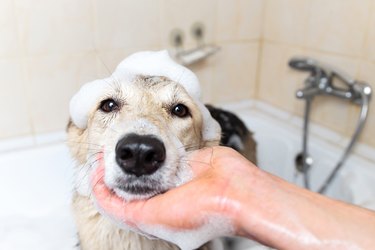Flea and tick shampoos for dogs are specially formulated with an insecticide that kills both insects. Some flea and tick shampoos also kill mites and lice, depending on the formulation. Several flea and tick shampoo products are available with different formulations, so read the label. However, even those shampoos that claim to kill mites do not kill all types of mites.

Video of the Day
Mites are microscopic parasites
Mites are microscopic parasites that burrow into the flesh of dogs. There are four types of mites that affect dogs. Demodex canis mites typically live on a dog, but the dog's immune system ordinarily resists the ability of the mites to multiply. Some dogs either are not born with the resistance to the mite or have a compromised immune system that allows the mites to proliferate, crowding out the hair follicles and causing the hair to fall out.
Video of the Day
The Sarcoptes scabei mite is contagious. Dogs infected with the Sarcoptes scabei mite will suffer intense itching, body scabs, and sores. Ear mites cause itching and yeasty festering in the dog's ears. Ear mites are contagious. Cheyletiella mites cause a flaky dandruff on dogs.
Ear mite treatment for dogs
Each type of mite responds to different treatments. Demodex mites require a special dip or topical application of amitraz. Flea and tick shampoos containing amitraz will be effective in controlling demodex. Dogs with Sarcoptes scabei mites need medical attention from a veterinarian. Special prescription shampoos help treat the infestation of Sarcoptes scabei mites along with oral antibiotics to treat secondary infections.
Treatment for ear mites involves treating the ears for infection, yeast overgrowth, and killing the mites. Flea and tick shampoos with pyrethrin may kill mites that run to other parts of the dog's body. Cheyletiella mite can also be treated with flea and tick shampoos containing pyrethrin. However, a veterinarian should always inspect your dog to treat for any bacterial infections resulting from these mites.

Shampoo for mites chemical compounds
Pyrethrin refers to any of six chemical compounds derived from chrysanthemum plants for use as an insecticide. It is an active ingredient in many flea and tick shampoos. The chemical is harmless to humans and dogs if used according to the label but cats have a lower tolerance to it. However, dogs who have a negative reaction to pyrethrin may salivate, vomit, have tremors, or even seizure. If you see these symptoms in your dog, contact your veterinarian immediately.
Using shampoo for mites
Read the instructions and ingredients to ensure you use the shampoo appropriately. Place cotton balls inside your dog's ears to protect them from getting wet. Wet the dog thoroughly and lather the shampoo on the fur. Massage the shampoo for a few minutes, then rinse well.
Never use human shampoos on dogs. It's also a good idea to regularly launder your dog's bedding (including any blankets or pillows they use) to prevent infestation and to keep them clean after their bath.
Best mite treatments for dogs

Speak with your veterinarian if you suspect your dog suffers from a mite infection. The veterinarian can advise you on the appropriate treatment for your pet's condition. They will do a physical examination, and treatment should include other pets in the household. Mites can spread from one animal to another as they are in contact.
Additionally, always inspect your dog's skin and coat regularly for any mites, fleas, and ticks. Check their ears and paws as well.